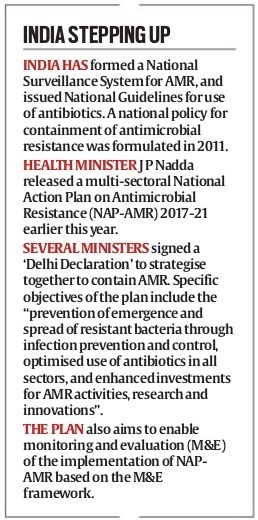What is CARB-X, and why was it instituted?
- CARB-X, or Combating Antibiotic Resistant Bacteria Biopharmaceutical Accelerator, is a public-private international partnership, which was set up in 2016 to focus on innovations to improve diagnosis and treatment of drug-resistant infections. It grew out of President Barack Obama’s 2015 Combating Antibiotic Resistant Bacteria (CARB) initiative, and is funded by the London-based biomedical research charity Wellcome Trust, and the Biomedical Advanced Research and Development Authority (BARDA) of the US Department of Health and Human Services.
- “The partnership provides a new, collaborative approach to speed research, development and delivery of new antibiotics, vaccines, diagnostics, and other innovative products to address the urgent global problem of drug-resistant bacterial infections,” Kevin Outterson, Executive Director of CARB-X and Professor of Law at Boston University told The Indian Express in an interview.
- CARB-X is headquartered at BU Law, and will provide grants up to $ 455 million (over Rs 2,900 crore) over a five-year period to firms across the globe for antibiotics R&D. Two sets of funding, covering 18 projects in six countries, were announced on March 30 and July 25 this year. All CARB-X funding so far is focused on projects to address the most resistant “Gram-negative” bacteria.
So, what are Gram-negative bacteria?
- Bacteria are classified as Gram-positive and Gram-negative, based on a structural difference in their cell walls that is detectable through a staining technique developed in 1884 by the Danish bacteriologist Hans Christian Gram. Gram-negative bacteria are responsible for 20-25% of infections, and are multi drug resistant — which is the ability of bacteria to defend themselves against drugs that try to kill them.
- Antibiotic resistance has become a global crisis that threatens the management of infections, both in the community and in hospital practice. The major reasons are the indiscriminate use of antibiotics, including against viral infections, especially in countries like India where they are commonly available over the counter; their prolonged use in patients admitted to hospitals; and their abuse in animal husbandry as growth promoters. Cheaper antibiotics such as penicillin, tetracycline or co-trimoxazole can often no longer cure an infection, and high-end ones like third- and fourth-generation cephalosporin and carbapenem are commonly used, doctors in India believe. In hospital critical care units, more than 50% organisms are now resistant even to these drugs.
- Technically, antibiotic resistance is a subset of antimicrobial resistance (AMR), which is a wider category that covers resistance in all microorganisms — bacteria, parasites, viruses and fungi — to drugs. But as antibiotics (drugs against bacteria) are the commonest antimicrobials, the two terms are often used interchangeably. Some 700,000 people die of resistant infections every year globally, a number that is estimated to rise to 10 million by 2050.
OK, but is there a reason for India to be particularly interested in CARB-X and AMR?
- One, India, because of its sheer numbers, poor literacy and awareness, and lax controls over medical practices, is on the frontlines of the global AMR public health crisis. A 2015 WHO multi-country survey recorded “widespread public misunderstanding” about antibiotic use in India, and Health Minister J P Nadda, in April 2016, flagged antimicrobial resistance as a “serious threat to global public health”. As per the National Action Plan on Antimicrobial Resistance (NAP-AMR), the crude mortality from infectious diseases in India is 417 per 100,000, and India is among countries with the highest burden of bacterial infections.

- Two, an Indian company, Bangalore-based Bugworks Research, has received an Initial fund of $ 2.6 million (about Rs 16.6 crore) for its work on a new class of antibiotics to fight what is known as the “ESKAPE” group of pathogens (Enterococcus faecium, Staphylococcus aureus, Klebsiella pneumoniae, Acinetobacter baumannii, Pseudomonas aeruginosa, and Enterobacter species). “ESKAPE pathogens are considered the leading cause of nosocomial (hospital-born) and hospital acquired infections throughout the world. Most of these strains are multidrug resistant isolates, and treatment of these infections is one of the greatest challenges in clinical practice,” co-founder of Bugworks Research, Santanu Datta, told The Indian Express.
- And how do independent experts see projects like CARB-X?
- Professor Balaji Veeraraghavan, Head, Clinical Microbiology, Christian Medical College and Hospital, Vellore, told The Indian Express: “In the recent past, no new antibiotics have been approved for clinical use. Regardless of ongoing efforts to develop new agents, government and private sectors must be alert and promote drug development. It is of supreme importance to have more initiatives like CARB-X for the development of new antimicrobial agents. This would ultimately reduce the ever-increasing gap between rising antimicrobial resistance and declining rates of the discovery of new agents.”
- Professor Pallab Ray of the Department of Microbiology, PGIMER, Chandigarh, said initiatives like CARB-X are required not only at the global level, but in India as well. “There is no dearth of data on AMR, there are policies in most hospitals, declarations on how to take the bull by its horns. What we lack is an administrative structure to implement it. The need of the day is programmes to implement the control measures empowered by administrative control and legislative binding on every user of antibiotics,” he said.
INDIA STEPPING UP
- India has formed a National Surveillance System for AMR, and issued National Guidelines for use of antibiotics. A national policy for containment of antimicrobial resistance was formulated in 2011.
- Health Minister J P Nadda released a multi-sectoral National Action Plan on Antimicrobial Resistance (NAP-AMR) 2017-21 earlier this year.
- Several Ministers signed a ‘Delhi Declaration’ to strategise together to contain AMR. Specific objectives of the plan include the “prevention of emergence and spread of resistant bacteria through infection prevention and control, optimised use of antibiotics in all sectors, and enhanced investments for AMR activities, research and innovations”.
- The plan also aims to enable monitoring and evaluation (M&E) of the implementation of NAP-AMR based on the M&E framework.
Source:IE
